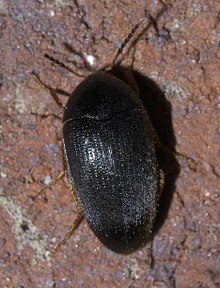Eucinetidae
| Eucinetidae Temporal range:
| |
|---|---|

| |
| Eucinetus stewarti | |
| Scientific classification | |
| Kingdom: | Animalia |
| Phylum: | Arthropoda |
| Class: | Insecta |
| Order: | Coleoptera |
| Suborder: | Polyphaga |
| Infraorder: | Elateriformia |
| Superfamily: | Scirtoidea |
| Family: | Eucinetidae Lacordaire, 1857 |

Eucinetus terminalis

Eucinetus morio
Eucinetidae is a family of beetles, notable for their large that cover much of the first ventrite of the abdomen, sometimes called plate-thigh beetles. The family is small for beetles, with about 50 species in 11 genera, but are found worldwide.
Adults are generally elliptical in shape, ranging from 0.8 to 4.0 mm in length, and black or brown in color. The head is small and bent underneath.
Eucinetids live in detritus or in fungus-covered tree bark, where both adults and larvae eat various sorts of fungi. Around half of the genera possess strongly modified mouthparts, particularly the labrum, adapted for suctorial feeding.[1]
Genera[]
These genera belong to the family Eucinetidae:
- Eucinetus Germar, 1818
- Euscaphurus Casey, 1885
- Bullians & Leschen, 2005
- Nycteus Latreille, 1829
- Ponomarenko, 1990
- Sakai, 1980
- † Hong 1995 Huachi-Huanhe Formation, China, Hauterivian
- Suctorial clade:
- Vit, 1985
- † Jałoszyński 2019[1] Burmese amber, Myanmar, Cenomanian
- Bisaya Reitter, 1884
- Vít, 1977
- Tohlezkus Vít, 1977
- Vit, 2000[2]
References[]
- ^ a b Jałoszyński, Paweł (August 2019). "†Cretohlezkus gen. nov. from Upper Cretaceous Burmese amber demonstrates ancient origins of suctorial mouthparts in Eucinetidae (Coleoptera: Scirtoidea)". Cretaceous Research. 100: 126–133. doi:10.1016/j.cretres.2019.03.016.
- ^ "Eucinetidae". GBIF. Retrieved 2018-04-12.
- , "Eucinetidae", in Ross H. Arnett, Jr. and Michael C. Thomas, American Beetles (CRC Press, 2002), vol. 2
External links[]
- Elateriformia (Coleoptera) - EUCINETIDAE Archived 2011-12-17 at the Wayback Machine
| Wikispecies has information related to Eucinetidae. |
Categories:
- Scirtoidea
- Beetle families
- Elateriformia stubs